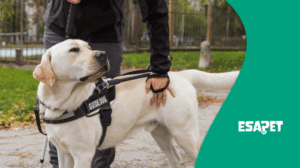Service Dog for Panic Attacks: Can They Help? (2026 Guide)

Service dogs are specially trained to assist people with various disabilities. These companions can perform tasks like bringing medication, providing physical comfort, and guiding their owners to safety. Their presence can be a lifeline for those struggling with mental health issues.
A service dog can be helpful for individuals experiencing panic attacks. These dogs are trained to detect early signs of an attack and respond appropriately. They can provide deep pressure therapy or bring emergency medications. They help mitigate the attack’s impact.
Besides practical help, service dogs offer emotional support, which is crucial during a panic attack. Their calm and steady presence can help ground their owner and reduce anxiety. This article will explore how a service dog for panic attacks can make a difference.
What Are Service Dogs?
Service dogs are specially trained to help people with disabilities, including:
These dogs get training to perform specific tasks that make the lives of their owners easier. Service dogs can help with mobility, alert their owner to sounds, or provide emotional support during a panic attack.
Having a trained dog has several advantages. They can increase independence, improve quality of life, and provide security. For people with panic attacks, these dogs can detect signs of an impending attack and offer comfort. This helps reduce the severity and duration of the episode.
Service dogs work by learning to recognize certain signals and responding in ways that assist their owner. Training service dogs can take months or even years, depending on the complexity of the tasks. Their assistance can be life-changing for those who rely on them.
Types of Support Animals
Support animals come in various types, each assisting with specific needs. Understanding the differences can help you choose the best type for your situation.
Emotional Support Animals
An emotional support animal provides comfort and support to individuals with mental health conditions. They provide comfort by just being with their owner. They don’t need special training to perform specific tasks.
ESAs are usually pets like dogs or cats. Their presence alone can help reduce symptoms of:
Psychiatric Service Dogs
Psychiatric service dogs get training to help individuals with mental health disorders. A psychiatric assistance dog can help with disorders like anxiety disorder, PTSD, or depression.
Psychiatric service dog training helps them perform specific tasks like interrupting self-harming behaviors, reminding their owner to take medication, or providing grounding during an anxiety attack. Anxiety service dogs are vital for those who need more than just companionship.
Service Animals
Service animals are specifically trained to assist persons with disabilities. The different types of service animals include guide dogs for the visually impaired, hearing dogs for the deaf, mobility assistance dogs for those with physical disabilities, and also mini-horses trained for specific needs.
A service animal undergoes extensive training. The training ensures a service animal can reliably assist their owners in various situations.
For more information on the differences between service animals and emotional support animals, check out our guide on Emotional Support Animal Vs Service Animals.
Service Dogs and Their Benefits for Panic Attacks
Panic attacks are sudden episodes of intense fear that trigger severe physical reactions when there is no real danger.
They can be terrifying, and people who experience them may feel like they’re losing control, having a heart attack, or even dying. Service dogs can be helpful for individuals who suffer from panic attacks.
Sensing an Impending Panic Attack
Service dogs can recognize changes in their owner’s behavior or physiological state. These changes include increased heart rate and sweating.

Providing Deep Pressure Therapy
During a panic attack, a service animal can apply gentle, steady pressure by lying across the owner’s lap or chest. By doing this, the dog provides a calming and grounding effect.

Fetching Medication
Service dogs can retrieve medication for their owner during a panic attack. This ensures timely treatment access when the person cannot move or think.

Guiding to a Safe Place
These dogs can lead their owner away from crowded or stressful environments to a quiet, safe space. This helps to provide security and help the person calm down.

Offering Emotional Support
The presence of a service animal provides emotional stability and companionship. This can reduce feelings of fear and anxiety during and after panic attacks.

Reducing the Frequency of Panic Attacks
The sense of security provided by a service dog can make stressful situations more manageable. They help decrease the frequency of panic attacks and improve the owner’s health.

You may find even more benefits of getting an Emotional Support Animal in our dedicated article.
What Type of Training Is Required for Service Dogs Assisting With Panic Attacks?
Training a service dog to assist with panic attacks involves several steps. The training starts with basic obedience. The dog learns to follow commands such as sit, stay, and come. This foundation is crucial for ensuring the dog behaves in various settings.
Next, the dog undergoes task-specific training tailored to the person’s needs. For panic attacks, this includes learning to recognize signs of an impending attack, such as changes in breathing or heart rate.
The dog gets training to respond to these signals in helpful ways. It can include nudging the owner, fetching medication, or applying pressure to the owner’s body to calm them down.
Socialization is another critical aspect of the psychiatric service dog training process. Service dogs must be comfortable in different environments and around various people and animals. This ensures they can perform their tasks reliably, regardless of the situation.
The training process can take months to years. It depends on the dog and the complexity of the tasks they need to learn. It requires patience, consistency, and a lot of practice to ensure the dog can provide the necessary support.
Who Can Get Psychiatric Service Dogs?
Individuals with a documented mental illness that impacts their daily lives can get a psychiatric service dog. These conditions can include anxiety disorders, post-traumatic stress disorder (PTSD), depression, and other mental health conditions.
To qualify for a psychiatric service dog, a person must have a diagnosis from a licensed mental health professional. The process starts with an evaluation from a healthcare provider. The professional determines whether a psychiatric service dog would be beneficial.
This professional provides the documentation to support the need for a psychiatric service dog. The person seeking an anxiety service dog must be willing to care for the animal, as this is a long-term commitment.
People interested in obtaining a psychiatric service dog should consider their lifestyle. Psychiatric service dogs will need regular exercise, grooming, and healthcare. The individual must be able to work with the psychiatric service animal to maintain its training and effectiveness. Therefore, the process of registering an ESA or a service animal needs to be conducted by serious companies that can provide orientation and licensed ESA letters and PSD letters.
How to Get a Service Dog
Getting a service dog involves several steps. First, you must determine if you qualify for a service dog based on your disability and needs. Consulting with a professional can help with this decision. Also, you need to consider service animal costs before starting the whole process.
Next, research service dog organizations that provide and train service dogs. Many service dog organizations have application processes, including interviews, questionnaires, and home visits. Finding a reputable organization is essential to ensure you get a well-trained service dog.
Once accepted into a program, they will place you on a waiting list. Training a service dog is lengthy, and there can be a high demand for these animals. During this time, they may ask you to participate in training sessions to help bond with your future service dog.
After receiving your service dog, you’ll undergo training together. The training ensures you can work effectively as a team. This training helps you understand how to use the dog’s skills and maintain its training.
Get Your Legit PSD Letter in 3 Easy Step
ESA Pet makes getting your legitimate PSD (Psychiatric Service Dog) letter easy. Follow these simple steps to get started today.
Step 1: Finish the Quick 2-Minute Screening
You need to complete a quick 2-minute screening to get your legitimate PSD letter. This involves answering a brief survey with easy questions about your emotional and mental health.
Step 2: Speak with a Qualified Medical Expert
After completing the screening and making a secure payment, ESA Pet will connect you with a licensed professional in your state. They will evaluate your emotional and mental health. They do this to determine whether a psychiatric service dog would benefit you.
Step 3: Get Your PSD Letter
If approved, the certified health provider will issue a signed PSD letter. You will receive your official PSD letter within three business days.
Get your Official PSD Letter Consultation from a licensed therapist.
Get PSD Letter NowFAQs about Service Dog for Panic Attacks
Can Service Dogs Help With Panic Attacks?
Yes. Service dogs can help individuals experiencing panic attacks. They can perform specific tasks to mitigate the effects of an attack. The tasks include applying pressure to the owner’s body or fetching medication.
Can a Dog Be Trained to Detect Panic Attacks?
Yes. Service dogs are trained to detect early signs of a panic attack by identifying specific cues. These cues include changes in their owner’s behavior or physiological state. Training involves reinforcing the dog’s response to these signals to assist effectively.
How Did I Cure My Panic Attacks Naturally?
Curing panic attacks naturally can involve various strategies. These strategies include practicing mindfulness, physical exercise, and a healthy diet. Many people also find techniques like deep breathing and meditation helpful.
Is There a Number to Call if You’re Having a Panic Attack?
Yes. If you are experiencing a panic attack and need immediate assistance, you can call emergency services or hotlines such as the National Suicide Prevention Lifeline at 988. It’s important to have access to support when needed.
How Much Does a Service Dog Cost?
The cost of a service dog can vary but typically ranges from $15,000 to $30,000. This includes the training required for the dog to perform specific tasks and assist its owner.
Conclusion
A service dog for panic attacks can be incredibly beneficial. These dogs can detect early signs of panic attacks and provide comfort. Their presence can reduce the frequency of panic attacks. They help improve the quality of life for individuals with mental illness.
Service dogs go through extensive training to perform tasks. They can be life-changing for those who rely on them, providing practical and emotional support. Understanding the types of service animals and their roles can help you decide which type is best for your needs.

Dogs, Emotional Support Animal, Housing, Travel
Service Dog for Anxiety: Learn How PSDs ...
Stephane Bandeira
Dec 17 2025

Dogs, Emotional Support Animal, Food, Housing
5 Dog-Friendly Stores: Where to Shop wit...
Jonalyn Dionio
Jan 14 2025












